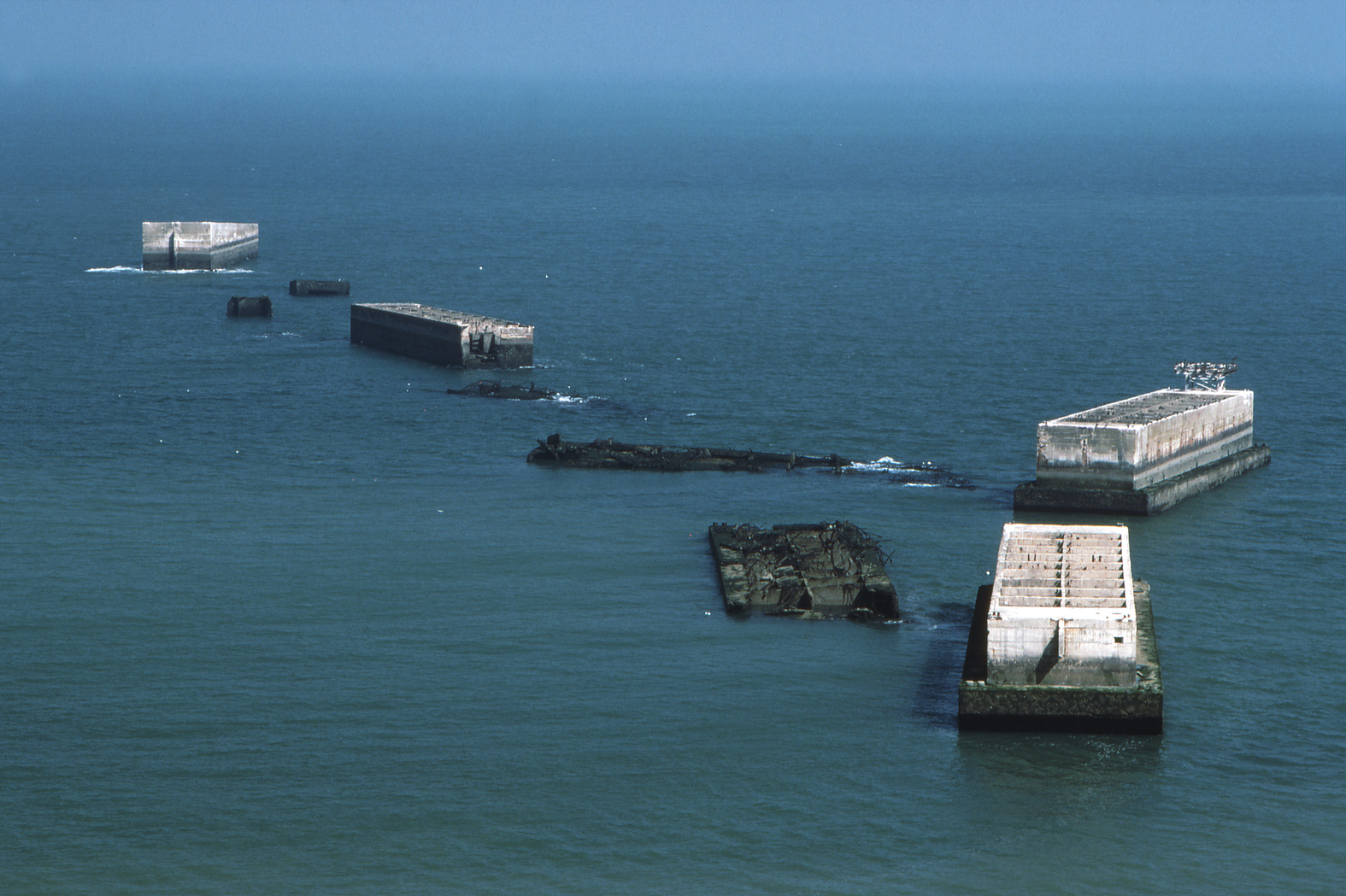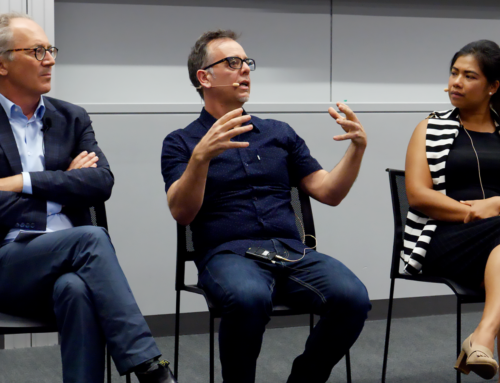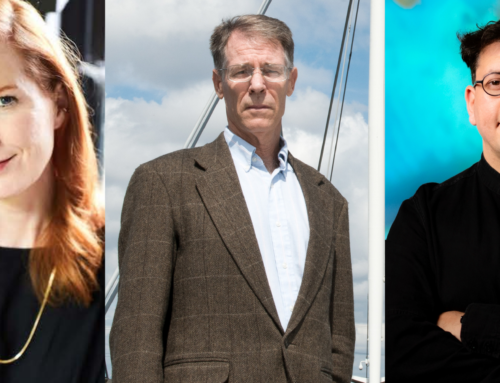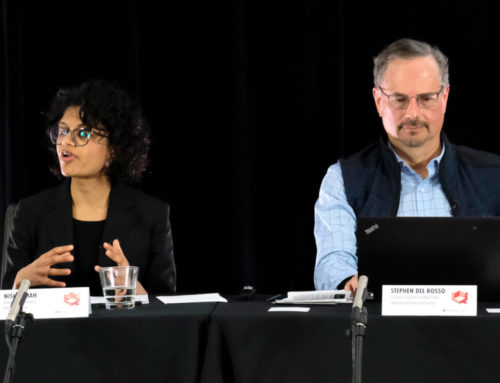With Friday’s opening panel on The Space-time of War and Diplomacy having established Q2’s overall theme, subsequent panels explored simultaneously the distinctive qualities and complementarity of its components of space, time, war, and diplomacy.
In the opening panel, both Stephen Kern and Arthur I. Miller emphasized the significance of technological, cultural, aesthetic, and scientific innovations to the representations and perceptions of space before and during the First World War. After a brief break, the conversation went deeper in the panel on “Space: Geopolitical, Galactic, and Virtual”. Presentations by Andrea Loehr, Mark Salter, and McKenzie Wark brought insights from astrophysics, history, and critical political theory to bear on perceptions of inhabiting and moving through space(s) at scales galactic, planetary, and subjective.
The panel started with the big bang as astrophysicist Andrea Loehr opened with her presentation on the cosmological principle as it relates to space, perspective, and limits. Her talk began with a bit of etymology. “Cosmos”, she explained, came from the Greek word for order (antonym: chaos) while “universe” derived from the Latin for “whole”. The “order” implicit in cosmology comes in the cosmological principle, which states that when viewed on a large enough scale, the distribution of matter in the universe is isotropic and homologous. That is to say, that matter across the universe will reproduce the same forms and structures (homologous) and it does so in all directions (isotropic).
In his Q Lecture the night prior, McKenzie Wark discussed Paul Edwards’s description of climate science as a reproductionist science, in that models provide mediation between data, apparatus, and theory. Loehr’s presentation highlighted the use of similar approaches in cosmology. With one click from Loehr, a dazzlingly dense web of what appeared to be purple marble or some kind of organic tissue under magnification projected onto the screen behind her.
This, she explained, was the Millennium Simulation. The simulation, first performed on a supercomputer over the course of a month in 2005, modeled the distribution of dark matter in the universe and simulated the evolution of 10 billion particles in space over a space of 2 billion cubic light years. With another click, we began zooming in. The marble gave way to something more like an urban landscape as seen from a nighttime flyover, before zooming in finally at a distance resembling an impossibly rich night sky. Each luminous dot, she explained, represented not a star but an entire galaxy cluster, each with hundreds or thousands of galaxies, themselves containing vast amounts of stars. By comparing real data and observations with those of the simulation and its successors, cosmologists can test their theories and explain how new, potentially challenging, observations can be accounted for in extant theories of cosmological evolution.
Loehr explained that a homologous and isomorphic universe is the expected corollary of the cosmological principle’s core contention that there is “no preferred observer” to the universe. There is, then, no center and no primary subject. Contra the earlier panel’s comments by Glenda Sluga, who had stressed that historians had moved away from “that noble dream” (h/t Peter Novick) of objectivity, Loehr asked what the impact would be if there was no preferred historical observer? What homologous structures would emerge?

Andrea Loehr delivering her presentation, entitled “Space: Perspective and Limits.”
(Photo: Gilbert Bel-Bachir)
But cosmological observation is not omnipotent, limited as it is by the event horizon. Where Chris Fuchs’s presentation on the QBist interpretation of quantum mechanics emphasized how the act of observation acts on the universe, the event horizon is the means by which the physical laws of the universe conspire to obscure some parts of itself from observation. Hubble’s Law, Loehr explained, was the discovery that objects in extragalactic space, when viewed from Earth, appear to not only be moving away from us but seem to be accelerating as they move away. The observational limit of the universe is the event horizon, a point at which events and objects are so distant that the photons they emit, despite traveling the speed of light, will never reach an observer at another point as the two points are also in motion away from one another. Where, Loehr wondered aloud, is the event horizon for history in light of accelerationism? In the historiography of a war that began with progressive “points of no return” in diplomacy and mobilization, what is the event horizon limiting our observations as the object of study recedes into the past?
Mark Salter, professor of political science at the University of Ottawa, shifted the panel’s gaze from the movements of celestial bodies to human ones. His presentation portrayed passports as the homologous and isomorphic corollary of states’ efforts to reduce the chaos of individual identities and subjectivities moving through spaces to an ordered, and thus governable, cosmos, only with the state situated as the “preferred observer”.
The social and destructive forces unleashed by the war and its diplomatic settlements changed borders and nationalities and reshaped the spaces of the international. People crossing new borders and navigating novel nationalities came to rely on the passport, an innovation combining advances in technologies like photography with the expanding scope of international and national bureaucracies as a regulatory force.
Salter described how works on the advent of the modern passport tend to treat the passport as a solution to the new post-war configurations of states, territories, and nationalities. Though his interest, he explained, was drawn not to the problems the passport solves, but those that it creates.
He recounted an argument between a young woman and a state official who refused to list the woman’s hair color as blue. The encounter highlights two anxieties. The woman whose real, material identity is undermined fears the document’s misrepresentation of her subjectivity, while the state bureaucrat worries that the document’s utility is lost by the increasing artificiality or transience of its holder’s hair color.
This was less of a problem with early passports. These one-off documents were intended to secure the passage of their holders (and their presumably more naturally colored hair) for single trips or journeys. The pictures were more in line with the portraiture of the times, the accompanying text a combination of narrative and description to accurately describe its holder and their situation.
But the passport became “the dominant form of international identification” between the wars, a response to refugee flows, the dissolution of the Austro-Hungarian empire, and a spate of newly independent states. By 1927, the League of Nations, spurned in part by the success of the “Nansen passports” issued to refugees made stateless by the war and its aftermath, had codified and bureaucratized the now standard documents into more of the form they take today.
As is so often the case, hegemony comes with its own problems. Why, Salter wondered, does everyone take such terrible passport photos? Given their materiality and function as a real object of identity, why do they so consistently alienate those they represent? For Salter, the answer lies in that the passport is necessarily a site of contestation between the fluidity, relationality, and entanglement of individual identity and the state’s increasingly invasive impulses to fix its subjects in time and space. This attempt at fixity produces performativity. Crossing borders involves an anxious performance: we anticipate questions, edit our stories, and mentally rehearse our responses in preparation to be interpreted by gatekeepers, themselves performers attempting to catch deceit.

Examples of unacceptable passport photos provided in a guide produced by the Government of Canada. (Photo: Government of Canada)
Meanwhile, passport photography is now designed to help computerized algorithmic analytical tools, whose effectiveness is contingent on the uniformity of the reviled passport photos. This additional capability for the state spells a subtraction of identity for the subject, whose photograph now requires they remove all affect from their portrait. Our passport photos don’t look like us, Salter explained, because they cannot possibly be us. In attempting to fix our identities in space and time, their materiality cannot possibly capture that which it purports to represent. The passport as an object, then, takes on elements of Lacan’s mirror stage. It presents to the state an impossible image of a unified, ideal body– dependent on external recognition but unable to account for or represent the excesses of subjectivity of our actual personhood.
Q attendees were now familiar with the notion that the act of observation changes the system being observed. This, Salter explained, extends to our identities and rights while crossing borders. The necessary negotiation between a sovereign claiming the right to deny and an individual claiming the right to enter results in performance, creating a space of flux and ambiguity in which movement outcomes are defined less by the classical appeals to rights and laws and more by the active impacts of observation and decisionism.
The delineations of space and sovereignty that led, among other things, to the spread of passports and the increasingly bureaucratized regulation of movement and migration over the course of the last century ran parallel to accelerated efforts of science and labor to control the entire planet. McKenzie Wark’s presentation contended that it is now clear that the scientific endeavors that attended and accelerated intra-human affairs of interstate violence and competition have resulted in an era of “impure war” in which the most drastic insecurity comes from attacks of social labor on the environment.
Throughout the twentieth century, Wark sees science as having advanced on four “fronts” of physics, chemistry, biology, and information science. Through advances in modern physics and chemistry, humanity could understand, harness, and weaponize the power and potential of the atom through splitting or synthesizing them. Meanwhile, the post-WWII synthesis of information science and biology have done much the same for the molecular humanity of DNA and RNA. For Wark, these scientific efforts have exponentially advanced humanity’s control of time and space on a global scale, as all levels of “nature” are subjected to scientific study and control.
The violence of such control, and its environmental and social consequences both intended and unexpected, characterizes the shift from an era of war predominantly between peoples to war to one between people and their environment. For Wark, the Anthropocene is an era of “impure war”— an epoch of metabolic rifts in the carbon, phosphorous, nitrogen, and water cycles; of looming climate wars; of the threat posed by rising sea levels. If knowledge, Wark put forth, is an instrument of strategy, then changes in the strategic conditions require changes to the production of knowledge. Science’s attempts to harness nature, previously subjugated to humanity’s fighting amongst itself, must now be put to work in a “third nature” demanding a new knowledge infrastructure on a planetary scale.
As no one really knows what the specific local effects of climate change will be, such science must be adaptive, collaborative, ingenious, and improvisational. As for what form such activities could take, Wark suggested the example of operations research undertaken by John Desmond Bernal in the Second World War. Despite his fervent Marxism, Bernal emerged as a leading advocate and practitioner in the use of science in the British war effort against fascism. Having published his seminal science studies text The Social Function of Science on the eve of the war, the acclaimed crystallographer applied his skills to the pressing problems of the British war effort.
His earliest efforts successfully predicted and then tracked the impacts of German aerial bombing during the Blitz, using a combination of statistical predictions, experimentation, and site visits to first help mitigate the German efforts before aiding the subsequent British strategic bombing efforts. After some implication in the abortive Allied landing at Dieppe in 1942, Bernal’s war took him to North Africa and then Canada, where he participated in Project Habakkuk, a delightfully weird effort to manufacture an iceberg of ice and wood pulp to serve as a floating mid-Atlantic airbase.
While this project would never come to fruition, Bernal would pursue a similar nature-making intervention in his efforts in support of Operation Overlord and the Allied invasion of Western Europe. Having analyzed the failure to capture a port at Dieppe, Bernal was crucial in helping develop the alternative of the Mulberry system of man-made harbors. The system used massive floating slabs and roadways, towed across the Channel, to allow the invasion to make an artificial harbor at the beachhead in Normandy rather than attempt to capture a heavily fortified port directly. Other efforts included eclectic endeavors to predict the conditions of the beach’s sand, crucial for landing Allied armor, which drew on disparate data points including postcards, medieval manuscripts, and the folk knowledge of French fishermen.

The persisting remains of one of the artificial “Mulberry Harbours” used by the Allies in the D-Day invasion of Europe. (Photo: Wikimedia Commons)
In extending Wark’s notion of the “impure war” between humanity and its environments, the example of operations research in wartime lends a sense of how scientific labour can be organized in human efforts to cope with the Anthropocene. What is needed then is an appreciation of the creativity and pluralism in strategies, methods, and materials that comes with such work, when the imperatives of victory prompt creative and ambitious attempts to attack problems from multiple angles.
Each presentation left a broad space of interpretation and interrogation for commenter Charlotte Epstein (of CISS and the University of Sydney). She prefaced her first intervention by noting the considerable efforts that IR scholars invest in searching for new ways of thinking about space and territory. Seeing space in the largest sense a la Loehr helps to denaturalize our taken for granted assumptions about the concept. But Epstein proposed going further through turning the concept on its head. What would happen if we were to think from place instead of space? Considering different means of mapping, like aboriginal songlines, and taking seriously the practices of traveling and relating to place, might help us to expand our critical inquiries.
From this point, Epstein emphasized the importance of reintroducing the post-colonial to IR. From her vantage, the field has yet to take the post-colonial seriously enough as a means to interrogate how our knowledge claims are situated and the impact of this perspective in terms of both scientific practice and political implications. In terms of practical knowledges, it enables different ways of knowing ourselves. If our thinking inhabits the places from which it emerges, we necessarily must think differently about taken-for-granted categories of space and time, with time less the passage of presents to a disappearing past but a past embedded and inseparably entangled with all possible presents.
Situated perspectives are also limited perspectives. Epstein noted the theme of limits in each of the three presentations: Loehr’s event horizon; Salter’s invocation of the Lacanian mirror state and misrecognition; and Wark’s contention that in climate science, simulation becomes “the root of a knowledge most real, contra Baudrillard”. For Lacan, the real is not reality; rather it is that which defies any attempt to know it. Global warming and the Anthropocene, Epstein pondered aloud, might be the real that defies our ability to know it. When Timothy Morton made a similar case in Hyperobjects, he rooted it in the object-oriented ontology movement in philosophy. But Epstein’s last point was more a provocative question than agreement: In a time of acceleration and virtuality where the real is harder to know, does the revived emphasis on the material stem from nostalgia? And are attempts to root understanding in the physical universe and the quantic a similar response? The conversation continued, first in questions from the audience touching on concepts of ego, the role of exile in the thinking many modern thinkers, and the individual subject as the state’s event horizon. They carried over to dinner, with pockets of participants picking apart the day’s themes along with their entrees.
After dinner, the crowd made their way to a nearby cabin where Q participant Mark Levinson – who would be presenting in the following morning’s panel on time– would be screening his 2013 documentary Particle Fever.
Levinson’s film provides an insider’s look at experiments looking for the Higgs boson conducted at the Large Hadron Collider at Europe’s CERN research consortium. In showing the labor of contemporary science at the highest scale, it explores the relationship between theory and experimentation and conveys the immensity of the project and its various components, all while providing a ethnographic glimpse into the inner workings of a scientific community of practice. The film was fantastic (and is available on iTunes or to stream on Netflix!): a fitting coda for a day of constructive and compelling discussions of the entanglement of science, knowledge, society, security, history, and politics.










[…] Lecture, Mckenzie Wark focused on the gaps that exist between data, models, and theory. On Friday, Andrea Loehr talked about the event horizon: the range at which two objects are so far apart in the universe that the photons they emit will […]